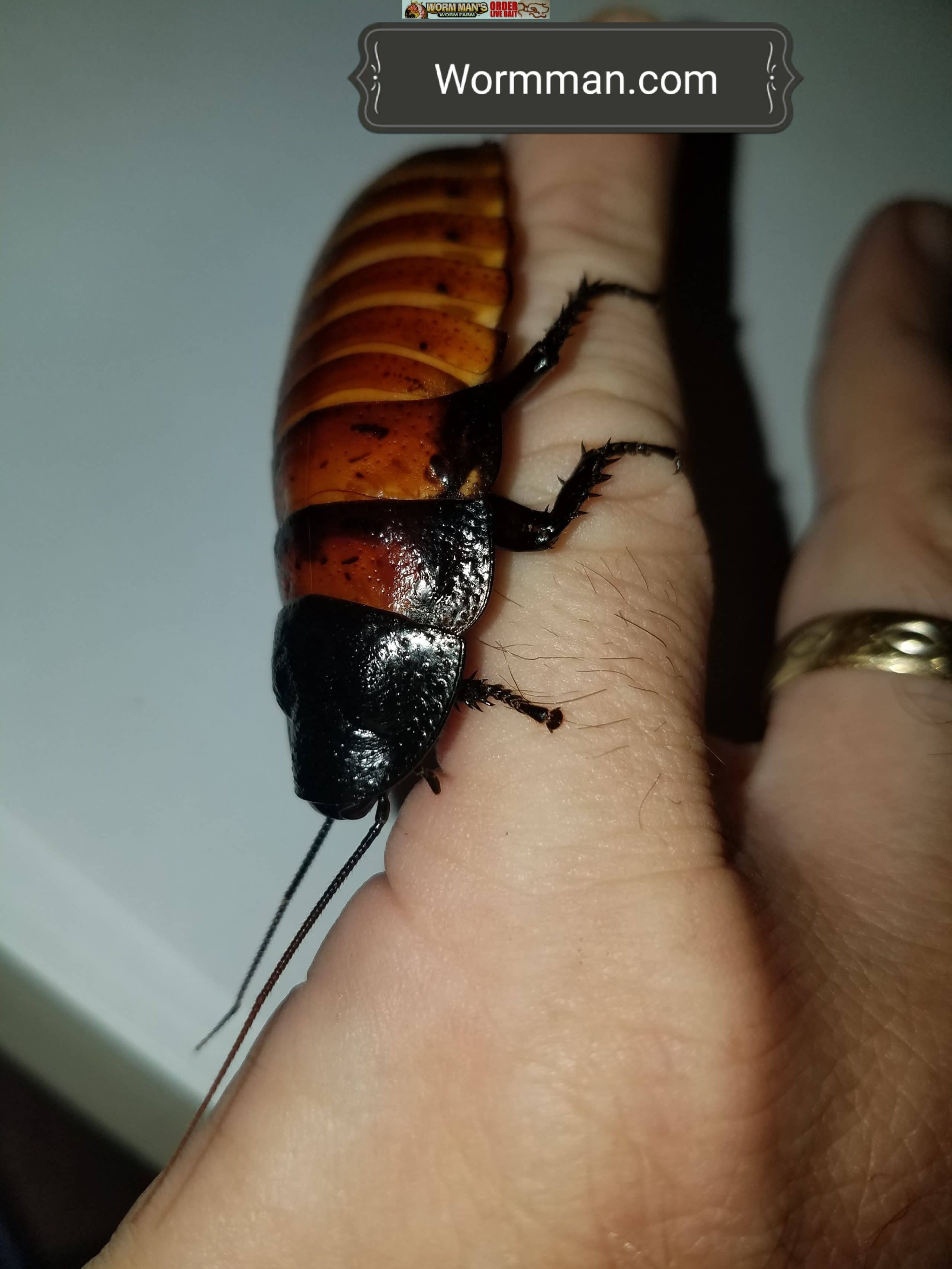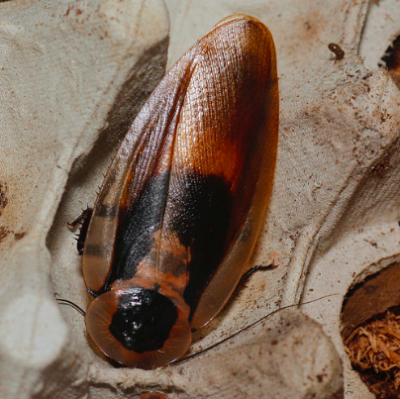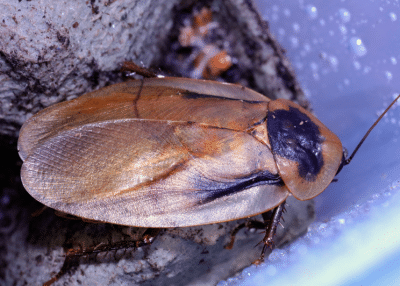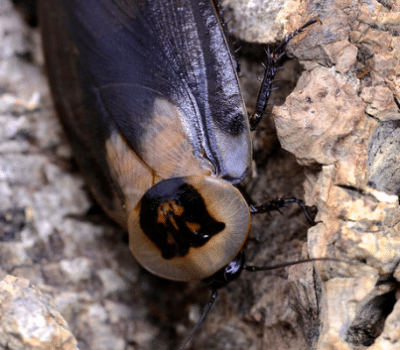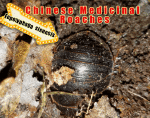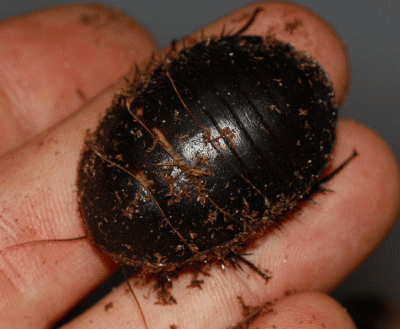Live Roach Care Sheets and Information
We have done our best to preserve this great database created by Cody Will. If you would like to add information, or correct anything here, please email us. We have many of the species below available for ordering and we will have most by spring. Thank you.
Archimandrita tesselatta
“Peppered Roach”
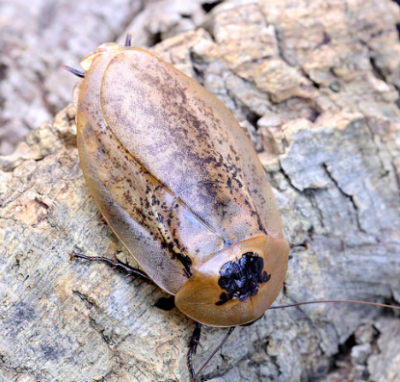
One of our all time favorite roaches, the Peppered Roach is one of the largest species available in the hobby, especially by weight. They are also very docile, though their leg spines can be quite painful if squeezed too tightly. These are found within the tropical climates of central America and do well when given moist substrate and moderate to high humidity. Young can take several months to mature, but the wait is well worth it! We recommend keeping some open vertical bark slabs for the subadult nymphs to climb onto when molting to adulthood. This will allow for proper wing formation. These reach ~2-3″.
Arenivaga floridensis
“Florida Sand Roach”
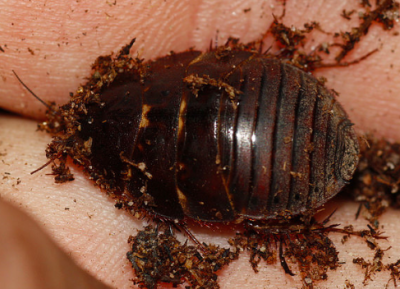
The Florida Arenivaga seemed to have eluded the hobby for quite some time. As advanced hobbyists have collected and then helped tackle the care needs of this genus, they are becoming more and more available now. This particular type was collected in central Florida. Though all Florida Arenivaga are classified as A. floridensis, this dark variety has been shown to genetically differ significantly from the “white” floridensis – so much to the point that it will likely be deemed a separate species in time. Unlike the other Arenivaga that should be kept mostly dry with regular, slight moisture, these tolerate more moist conditions overall. Adults reach ~.5″.
FLYERS
Arenivaga tonkawa
“Tonkawa Sand Roach”
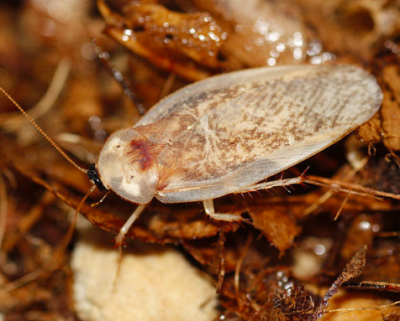
The Tonkawa Sand Roach is a very widespread species found throughout the southwestern deserts of the United States. Like others in the genus, they are sexually dimorphic with the males fully winged and females lacking wings entirely. Despite their name, sand roaches do best in a soft, mixed substrate of crushed leaf litter, coco, peat, etc – and with little to no sand. In the wild they typically inhabit the “dusty” layer of detritus that accumulates in rodent burrows. If kept in coarse sand (which can be quite abrasive) the roaches tend to dessicate quickly and die. They feed almost entirely on dried leaves and consume very little food in general. Dog food or fish flakes should also be provided occasionally for protein. Though they are found in deserts, they require regular slight moisture which mimics the cooler, moist conditions often found in the rodent burrows a few feet beneath the surface. All of this said, it is a farily sensitive species and is recommended for advanced hobbyists. Adults reach ~.5″.
FLYERS
Aeluropoda insignis
“Flat Body Hisser”
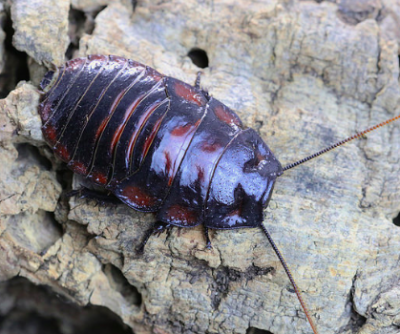
The only representative from the genus Aeluropoda, A. insignis gets its common name from its unusually flattened body when compared to the other hissing roaches from Madagascar. These are an easy species to cultivate and like other hissers are great for handling. However, they are excelent climbers and good escape artists. A tight fitting lid is an absolute must to keep small nymphs contained. Flat body hissers prefer things dry and do well on normal roach fare of fruits, veggies, and dog food kibble. Size 1.4-2.5″+.
CLIMBERS
Blaberus discoidalis
“Discoid Roach“
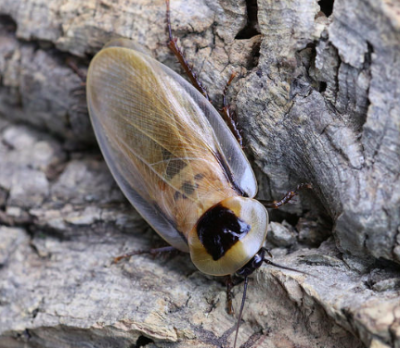
The discoid roach is a very popular feeder roach, having a fast life cycle and reaching a decent size. The nymphs are enjoyed especially by large tarantulas and lizards including bearded dragons. Unfortunately this species is capable of hybridizing with some other Blaberus species (i.e. B. atropos) and the purity of many lines are not completely known. Regardless, this ridiculously easy, fast breeding and fun species makes a great addition to the low maintenance roach collection or feeder roach supply. Some specimens of this species have a nice, especially rounded shape compared to others and we are always selecting for this trait in our colony. Adults reach ~1.4″-1.8″.
The dusky cave roach, also known as the dwarf cave roach, is a large, fairly quick breeding Blaberus species that serves as a great pet as well as larger feeder. There is controversy over the true identity of this species. In Europe, it is considered a brown winged morph of B. craniifer, while others claim it to be a hybrid between craniifer and other Blaberus species, and the remaining group identifying it as species B. fusca. This species is quite large, grows and breeds quickly, and is easy to care for when given the proper conditions of a spacious, moderately moist enclosure. Adults reach 2-3″.
Blaberus giganteus
“Giant Cave Roach”
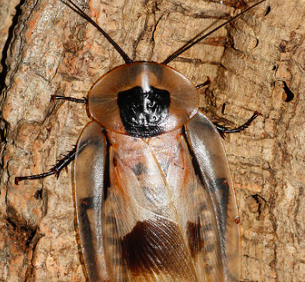
The king of Blaberus, the giant cave roach as its name suggests is a very large cave roach species (it is the largest species of Blaberus by length). This species is best kept in a spacious enclosure with multiple verticle surfaces which can be especially important for proper molting. Adult males of this species tend to harrass one another and it is best to cull excess males if a colony becomes too crowded. If you do not, they will do this themselves. Like most other Blaberus, these do best with a moist substrate and regular diet of fruit and veggies. Adults can reach in excess of 3.5″.
Blaptica dubia
“Guyana Orange Spotted Roach”
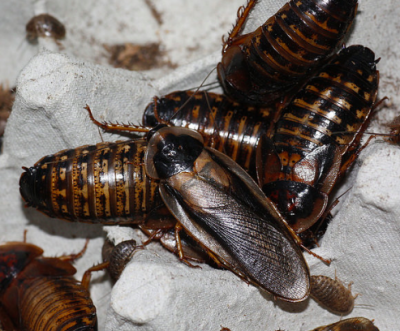
The Guyana orange spotted roach, or more commonly known now as the dubia roach, has quickly become one of the world’s most popular feeder insects. With their ease of care, quick reproduction, high nutritional content, etc – it’s no wonder that they have essentially replaced crickets as a feeder in many situations. Nymphs are mostly a grey color, while adults can be quite beautiful. Males are mostly dark and are fully winged, while females range from very dark to golden and have a nice striped to spotted pattern. Whether pet or feeder, this is a beautiful and very easy species to keep. No collection is complete without it! We can also sell this species by size and in virtually any quantity. Just ask! Adults reach ~1.5-1.9″.
Blatta lateralis
“Turkistan Cockroach”
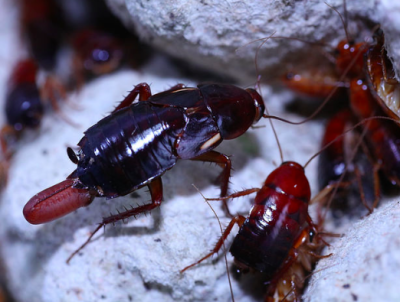
This species has recently been placed in the genus Shelfordella despite being known as Blatta lateralis for years. The common name is also a source of confusion since they are called both “Turkistan Roaches” or “Red Runners”. All names aside, this is a very popular if not the best feeder roach available for several reasons. In good conditions, these breed extremely fast, they do not climb or fly (though adult males can glide a bit), they are soft bodied, and are very easy to culture. Adults are about the size of large crickets, except these roaches won’t keep you up at night with chirping. The quick red nymphs are also great for stimulating a feeding response out of finicky eaters. We can also sell these in bulk, please inquire. Reaching ~1″ as adults.
Blatta orientalis
“Oriental Cockroach”
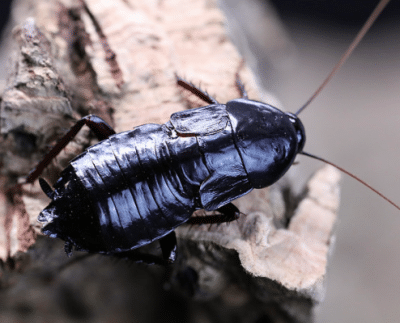
This was the species that bloomed Cody’s roach hobby interests and still remains one of his favorites to this day. These are a very easy species to culture though they do not reproduce quite as fast as B. lateralis. Though this species is technically considered a pest due to being found worlwide alongside humans, they are primarily an outdoor pest of moist environments such as sheds, hidden water spickets, etc. Fortunately they do not climb or fly and their deep purple/red coloration makes them an attractive species to culture. Additionally, this species is thought to have ancient medicinal value for treating asthma symptoms. Reaching .7″-1.2″.
Blattella asahinai
“Asian Cockroach”
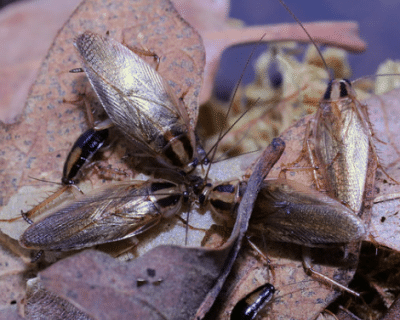
This German roach look-alike is a common sight of the southeastern United States where it’s a frequent inhabitant of leaf litter. These require more humidity than German roaches and are not an indoor pest. They are, however, a very fast, nuerotic species and if you are to ever culture them you can count on losing a few specimens here and there. At the slightest disturbance, they often run or take flight despite seeming to have no clue where they are going. Don’t say we didn’t warn you! These do best in a moderately moist environment with good ventilation. This colony began from a few individuals collected in Auburn, Alabama. Reaching ~.5″ as adults.
CLIMBERS, FLYERS
Blattella germanica
“German Cockroach”
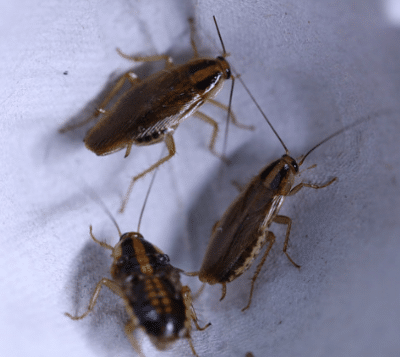
What? We have German cockroaches? Yep, believe it or not, we do. This species along with a couple others are responsible for many pest control companies’ paychecks. Needless to say, they are fairly easy to culture as long as they are provided with a mostly dry enclosure with good ventilation, yet still given adequate water (best way to accomplish this is to use water crystals). If you find yourself crazy enough to purchase these, please do keep in mind that they are a household pest and your colony may end up expanding beyond the container you keep them in. If you are truly insane, then buy some of these for your collection. Reaching ~.5″ as adults.
CLIMBERS, FLYERS *PEST*
Blattella nipponica
“Japanese Field Roach”
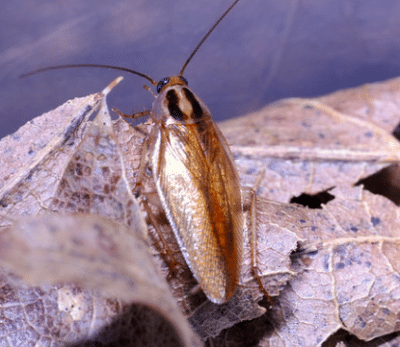
The Japanese field roach is similar to B. asahinai in both temperament and care, though it is a bit more tolerant of occasional lack of moisture. This species looks a lot like B. germanica but without the house-infesting capabilities, and acts a lot like B. asahinai with the jumpy, flighty nature when disturbed. They are a difficult species to culture, experiencing random die offs that can take careful care and time to bounce back from. Reaching .5″ as adults.
CLIMBERS, FLYERS
Blattella vaga
“Field Cockroach”
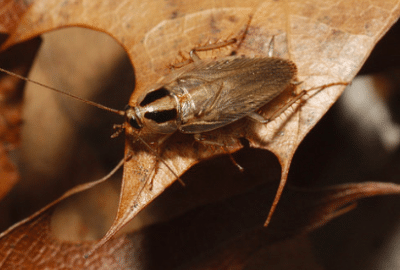
If you had to have at least one Blattella species in your collection, this should be it. These, in our opinion, are the prettiest species having the most contrast and uniformity in the pronotal and facial striping. In addition to looks, these are also not a household pest and do not tend to be as quick and flighty as B. asahinai or B. nipponica. They are also very easy to care for if given a good sized container with very good ventilation and plenty of cover. These are a common occurence in leaf litter of the southwestern United States though their range does include the eastern United States too. This colony originated from individuals collected at a park in Anderson, California. Adults are ~.5″.
CLIMBERS, FLYERS
Another unique Blaberus species that has yet to be identified. These come from Venezuela and are a medium sized species that are like all other hobby Blaberus in terms of care and temperament. That said, keep in a moist substrate with some hides, feed lots of fruits and veggies with some protien, and they should thrive. These are comparable to B. discoidalis but are a bit larger and the black pronotum spot varies from dark to a light red with a slight “face” similar to B. craniifer. Adults reach around 2″.
Blaptica
Like the polymorphic roach above, the Bolivian roach is one of the smaller Blaberus species, being equivelent in size to B. discoidalis. What makes them unique is their nice brown wings and dark pronotum that often has two red spots. They are an easy, forgiving species to keep. These unfortunately hybridize with B. discoidalis and B. atropos – so keep them separate at all times. This colony comes from lines that were determined to be pure. This is our favorite of the “small” Blaberus varieties available within the hobby. Adults are ~1.5″-2″.
The death’s head cockroach is a very handsome species with their jet black and tan exterior, coupled with the iconic jack-o-lantern markings on the surface of the pronotum. They are a forgiving species if given decent humidity and a moist substrate, along with egg crate or cork bark for hides. They thrive on a diet of fresh fruits, veggies, and occasional protein. This species is a hobby classic and deserves a space in every collection! It is arguably the most attractive Blaberus species. This line is a pure B. craniifer combination of Orin McMonigle’s strain (pictured) and the darker, robust UCR strain. Adults reach ~1.8-2.5″.
Blaberus atropos
“Polymorphic Roach”
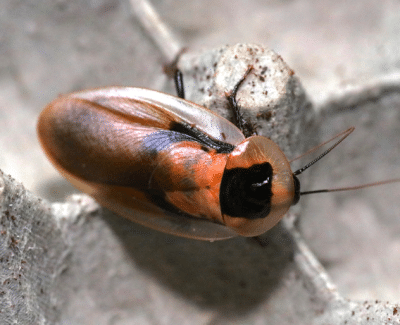
The genus Blaberus is probably the most popular genus of cockroaches in the hobby. With their large size and unique looks, combined with their ease of care and available variety – it’s no wonder! The polymorphic roach is one of the smaller Blaberus species, being equivelent in size to B. discoidalis. They get their name from the wide variety of pronotum patterns that pop up within a single colony. They are a very hardy species that prefer a moist substrate and some egg crate for hides. Though native to South America, these appear to have made their way to Florida where they were originally collected from. Adults range from ~1.5″ to just shy of 2″.
Balta notulata
”Small Spotted Cockroach”
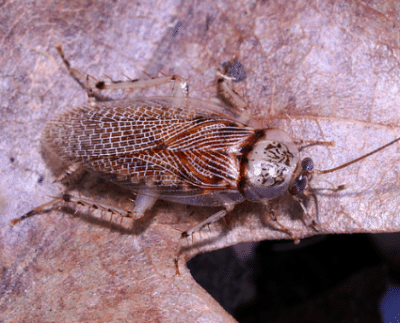
The given common name for this species does it zero justice. With its intricate reticalated markings, B. notulata is definitely one of those most beautifully marked Ectobiid cockroaches. They are a fairly speedy species and have a tendency to run upwards when disturbed. A tight fitting lid and side-access is highly recommended for keeping a colony of this species. These do best with regular low/medium moisture and good ventilation. Newborn nymphs are quite small and practically transparent. They also seem to take their time to mature, so have patience! Adults reach ~.3-.5″.
CLIMBERS, FLYERS
Balta vilis
”Small Tan Cockroach”
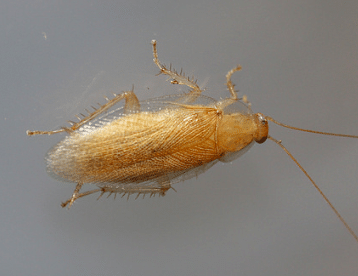
Balta vilis is essentually the golden version of B. notulata. Their care needs seem to be identical as well. Like B. notulata, this species is very quick, newborn nymphs are quite tiny, and both adults and young are good climbers and hoppers. A good caging system that doesn’t allow for many escapees is a must. Keep lightly moist with good ventilation. These seem to be a bit hardier and mature/reproduce more quickly than B. notulata. Adults are ~.3-.5″.
CLIMBERS, FLYERS
Byrsotria sp. “Cuba”
“Brown Burrowing Roach”Or “Cuban Burrowing Roach”
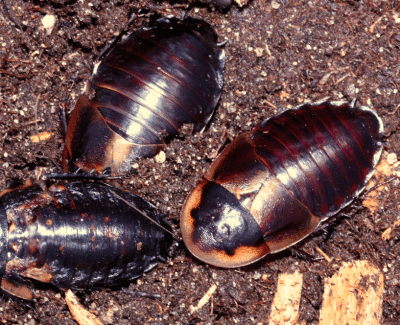
The burrowing roaches have gained momentum as both pets and feeders within the hobby. These are very equivelent to dubia in many respects including ease of care, reproductive rate, and build -though these are significantly larger (especially the females). This particular species and the other hobby Byrsotria are very easy to keep, being very tolerant of neglect if setup correctly. They enjoy a deep, moist substrate and some egg crate to occasionally hide in. Feed normal roach fare of fruits, veggies, and protein. Reaching 1.3-1.9″ as adults.
Cryptocercus wrighti
“Wright’s Hooded Wood Roach”
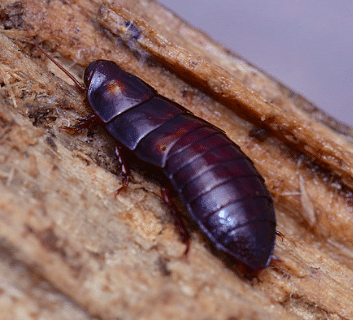
The genus Cryptocercus has yet to be figured out when it comes to captive husbandry. In the wild, groups inhabit inner galleries of soggy, rotten logs partially sunken into the ground. These are typically at higher elevations where things are fairly cool, though the microhabitat of these logs might differ greatly than the surrounding conditions. Needless to say, these are a wood eating species that require soft, spongy rotten wood. They also seem to be quite social. We are still working on culturing this species. So far, the trick seems to be a constant, cool, humid environment with plenty of rotting wood available. Our first attempt at this species included drilling holes into a rotten log and storing it in a wine cooler. They’re still alive, so maybe this is the trick! Though listed “out of stock” we do have a source for WC individuals. Please inquire. Reaching ~1″.
Compsodes schwarzi
“Schwarz’s Hooded Roach”
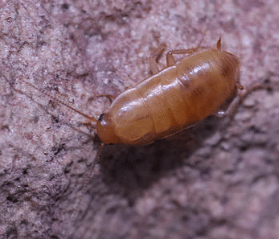
This is an extremely tiny species that recently became established in the hobby thanks to Alan Jeon. Believe it or not, the specimen in the photo is an adult female! It is a relatively easy species to culture as long as light to medium moisture with good ventilation is provided. You also have to be careful moving things around their containers, and be especially careful when misting. It’s easy for the tiny nymphs to get trapped in the water droplets that might land on or near them. Other than their physical fragility due to their small size, this is a relatively easy species to culture. Only adult males can climb/fly. Adults are under .25″.
CLIMBERS, FLYERS
Cariblatta lutea
“Small Yellow Cockroach”
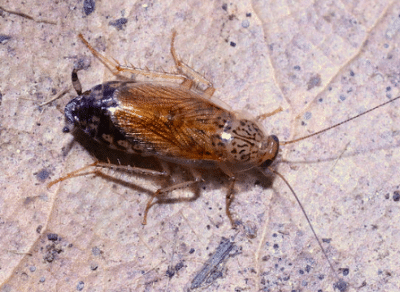
The small yellow cockroach is a widespread, tiny Ectobiid typically found amongst leaf litter across the Eastern United States. They are a fairly tricky species to culture, being very sensitive to too much moisture and lack of ventilation. That being said, a container of leaf litter with low moisture and high ventilation is key in rearing this species. This colony originated from individuals collected from a backyard in Atlanta, Georgia. Adults reach ~.25″-.3″.
CLIMBERS, FLYERS
Dorylaea orini
“Orin’s Zebra Roach”
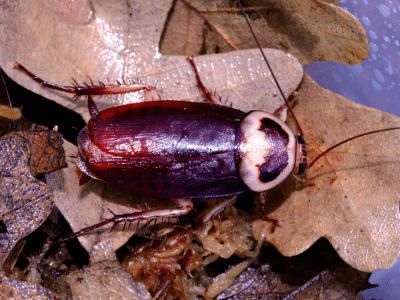
This beautiful roach is named after long time roach keeper and author Orin McMonigle. It is a striking species, with the striped nymphs looking very similar to nymphs of E. decipiens. Adults look more like a Periplaneta species with their red wings and blotched markings on the pronotum. This species needs moderate ventilation yet high humidity to flourish. Regular mistings are an absolute must. It is a fairly shy species spending most of the time in hiding. Adults are ~1-1.3″.
CLIMBERS, FLYERS
Drymaplaneta semivitta
“Gisborne Cockroach”
This beautiful species has finally made its way to the USA hobby after multiple failed attempts from various hobbyists. We were under the impression with these coming from a pretty moist part of New Zealand that they required humid conditions. Curiously, humid conditions will kill this species quickly in captivity. It turns out that they need to be kept bone dry with regular access to water. Again, this is where water crystals come in though some other hobbyists will leave a smaller moist container in their tub – almost like a roach steamroom. However you choose to set these up, just remember that they are DRYmaplaneta. Other than that, you should enjoy this very nice Eurycotis-looking species. One more thing to note, the oothecae need some moisture to hatch, and newborn nymphs are TINY and very flattened. Adults reach around 1″
CLIMBERS
Deropeltis paulinoi
“Ornate Velvet Roach”
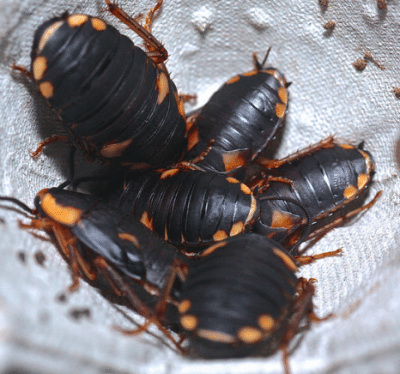
This beautiful species has been around for quite some time despite many roach keepers’ struggles to get colonies going. For whatever reason, two people can have an identical setup and care, yet one will have great success while the other’s colony dies out. That said, it is recommended for advanced keepers who aren’t easily prone to frustration. If you can get it going though, you’ll most certainly enjoy its great size, colors, and behavior. This species loves humidity yet can’t have “wet” conditions for too long. It is generally recommended to keep the substrate dry yet regularly mist the container to accomplish this. Good hides should be provided as it is a very shy species. Adults reach ~1-1.5″.
CLIMBERS
Dipteretrum hanstroemi
(No common name)
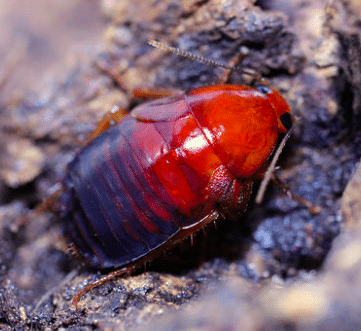
This interesting little roach resembles Parcoblatta americana, but comes from south Africa and is more robust. Nymphs are pretty much black until they mature as the red females or orange, winged males. These are brand new to the hobby and only a couple people seem to be keeping them which puts them at risk of either becoming established or not. Unfortunately, because of the wide variety of roaches and the small group of people keeping them, this can be true of many species. These are relatively shy and typically remain hidden. They can climb though, and the winged males can fly though almost never do. Newborn nymphs are quite small. Adults are ~.5-.8″.
CLIMBERS
Diploptera punctata
“Pacific Beetle Mimic”
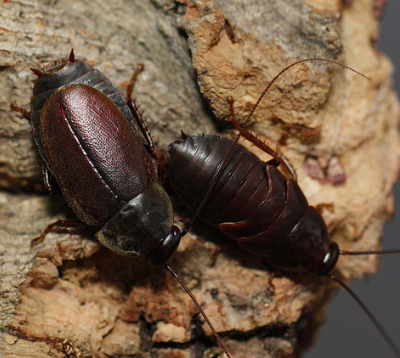
Another one of our personal favorites, this cute little roach mimics a small beetle. They are a common sight on some Pacific Islands including Hawaii. They have an interesting reproductive biology in that they are the only viviparous cockroach. The nourishment produced by females deemed “roach milk” has been the source of some hype within the scientific community and the media (google search roach milk!) Though they inhabit a tropical environment, this species prefers things on the drier side. They are also very good climbers and should be caged appropriately. Though they accept most typical roach fare, they also seem to enjoy nibbling on dried Pecan and Oak leaves. Adults range .7-1″.
CLIMBERS
Elliptorhina laevigata
“V-Horn Hisser”
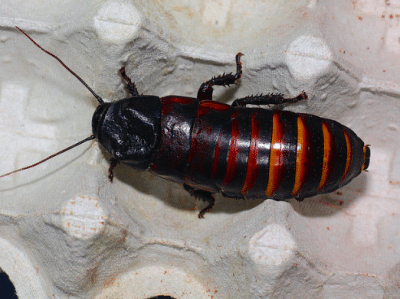
The V-Horn hisser is the largest hobby Elliptorhina species, often rivaling some Gromphadorhina in size and girth. They seem to have become very rare in the hobby and are kept by few. Like most other hissers, a mostly dry, spacious environment coupled with a variety of food items will allow this beautiful species to thrive in captivity. Adults can reach a whopping 3″+.
CLIMBERS
Eublaberus sp. “Ivory”
“Ivory Roach”
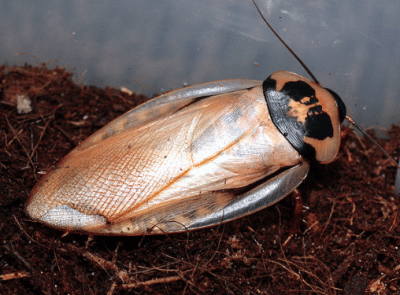
This beautiful species still has yet to be identified. They get their name from their ivory white coloration that is especially impressive on recently matured individuals. This said, they are lighter in coloration than E. distanti with a different pronotal pattern. Though these can also be wing biters, they are not quite as bad as E. posticus. Like all others in this genus, a deep, moist substrate is key for nymphs to be content, and foods should include fresh produce and protein. Pronotal patterns may vary but tend to mostly look like the specimen in the photo.
Eublaberus serranus
“Pantanal Roach”
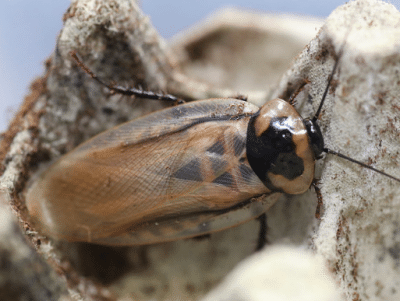
The headlamp roach, also known as the “Pantanal roach” is another great Eublaberus species available in the hobby. Their care is similar to others in the genus as well, prefering a moist, deep subsrate for nymphs to burrow in while adults enjoy perching on hides above the substrate. These come from the Pantanal wetland area of south America. Unlike E. posticus and sp “Ivory” these don’t seem to be guilty of any wing biting behavior.
Ergaula pilosa
“Black Beetle Mimic”
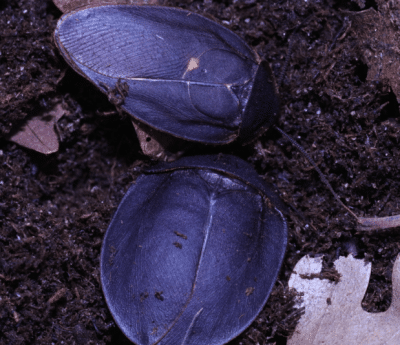
This species looks almost identical to E. capucina, but the stripe across the tegmina has been reduced to a single spot in the center. They also tend to be darker in color. They are identical in care to E. capucina and do well in a moist, soft substrate covered in leaves. Though they can climb and fly, they spend most of their time just below or resting on top of the substrate.
CLIMBERS, FLYERS
Ergaula capucina
“Burmese Beetle Mimic”
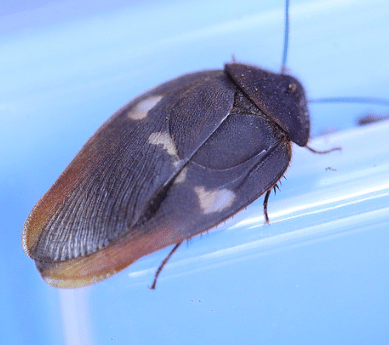
The Burmese Beetle Mimic is a very neat species. They tend to just kind of sit around all day, don’t eat a ton, and do well in captivity in general with a moist, soft substrate covered in leaf litter. With their ease of care and unique, beetle-like look of the females, they have turned out to be a popular species in the hobby. These are an egg laying species that leave very interesting-looking oothecae on the substrate surface.
CLIMBERS, FLYERS
Elliptorhina davidi
“Bumpy Hisser”
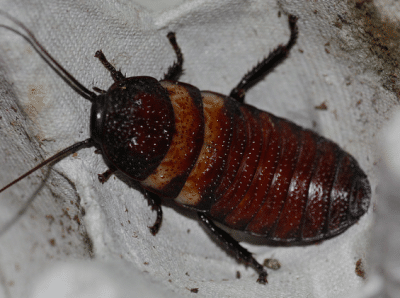
This small hisser is extremely rare in the hobby and the only hisser “difficult” to culture. They were accidentally imported from Madagascar as E. chopardi and do look pretty similar at a quick glance, other than the very “bumpy” look some have where this species gets its common name. They are similar in care to other hissers, but tend to experience random die offs. This is possibly due to the fact that every captive specimen is thought to have originated from a single pair and thus they may be suffering genetically. This may be one of a few instances within the insect world where inbreeding is clearly problematic. Adults reach ~1.8-2″.
CLIMBERS
Elliptorhina javanica
“Halloween Hisser”
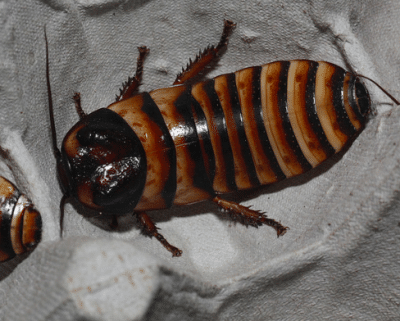
This is arguably the prettiest Elliptorhina species with their distinct, colorful striping. They are a bit bigger than E. chopardi, but are still considerably smaller than Gromphadorhina. Their care is similar to other hissers and they flourish if kept mostly dry and provided a variety of healthy produce and protein. Oranges seem to be a key food item to get the females to drop young. Adults reach ~1.8-2″.
CLIMBERS
Epilampra maya
“Mayan Cockroach”
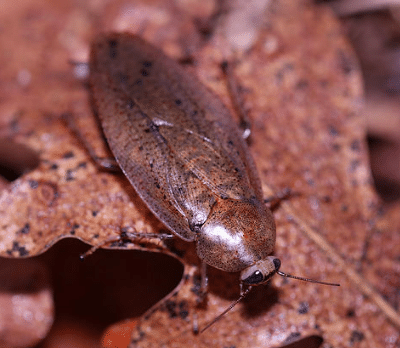
This very unique species was collected in Florida by long time roach hobbyist Kyle Kandilian. They come from a subfamily of roaches with semi-aquatic species, often living near a water source and diving beneath the surface of the water when disturbed. In captivity, stagnant water will cause more harm than good and luckily this species will do great if simply kept moist. We recommend keeping them in a fairly deep, chunky substrate with a thick layer of leaves on top. These will happily eat the leaves, too. With their high metabolism, an overcrowded colony is sensitive to crashing due to frass build up. Be sure to be ready to change the substrate occasionally, especially if kept in smaller containers. Adults reach about 1.2″.
CLIMBERS, FLYERS
Episymploce sundaica
(No common name)
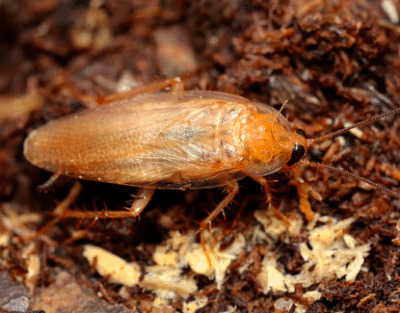
This little roach was brought into the US hobby and seems to have disappeared. They are a relatively easy species to keep, but due to their lack of size, flash, and abundance they are often overlooked. Though a lot of the orange/red hobby Ectobiidae seem to have wingless females on average, this is a species where both adult males and females have wings. These come from Australia/Indonesia and do best in a smaller, slightly moist container with good ventilation. These are quick and excellent climbers, reaching ~.5″ as adults.
CLIMBERS, FLYERS
Eublaberus posticus
“Orange Head Roach”
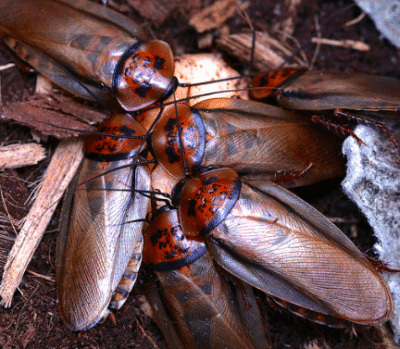
The orange head roach is a very attractive Eublaberus species with a bit less bulky nymphs than the others. These seem to stay under the substrate a little less than other Eublaberus if provided with egg crate or other hiding places too. This species is a notorious wing biter, with males chasing eachother around and biting off pieces of weaker male’s wings. Though this cannot be 100% avoided, it is much less of an issue if the colony is given adequate space, hides, substrate, and food high in protein. This species is such a ferocious eater, they will often eat other insects alive. Fortunately, the wing biting is about as cannibalistic as they get toward one another.
Eublaberus distanti
“6-Spotted Roach”
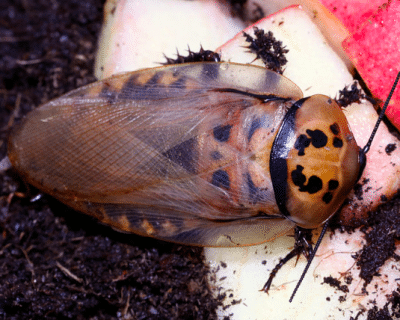
The genus Eublaberus is spectacular with some large, striking species. The 6-Spotted roach is no exception, getting its name from the spots on the pronotum which tend to total six on average. Nymphs of this species (and genus) are exceptionally bulky, and remain most of the time hidden in the substrate, moving about and bull-dozing the dirt with them. Adults also burrow but seem to spend most of their time above the substrate if there are obstacles to climb on and hide beneath. Keep warm and moist with a deep substrate for these to thrive.
Eurycotis lixa
“Hustler Roach”
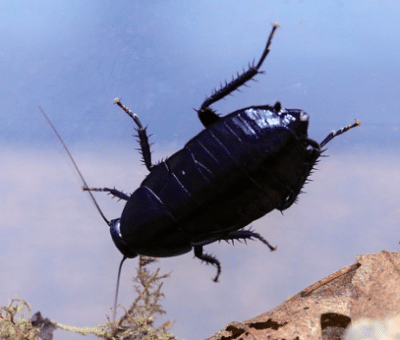
This is an awesome, underrated species of Eurycotis found in south Florida. They are a large roach and are comparable in size to E. floridana. These get their name and fame from sporting a deep, jet black coloration lasting from nymphs to adulthood. Unlike many dark roaches that appear black yet are actually a dark red (especially noticeable with flash photography) – this species is truly black all over. Like some other Eurycotis you will see them out in morning/early evening hours from time to time. Keep moist with plenty of cover.
CLIMBERS
Eurycotis opaca
“Scrub Roach”
An impressive, big Eurycotis species that comes from Cuba. Like all Eurycotis, they are good climbers and require a tight fitting lid. These are a rarely kept species that came from the European hobby, and come in two different color morphs based off the region they originated from in Cuba. The one offered here is the “Jaruco” form that has quite a bit more yellow coloration than those from “Soroa”. Comparable in size and care to E. floridana.
CLIMBERS
Elliptorhina chopardi
“Dwarf Hisser”
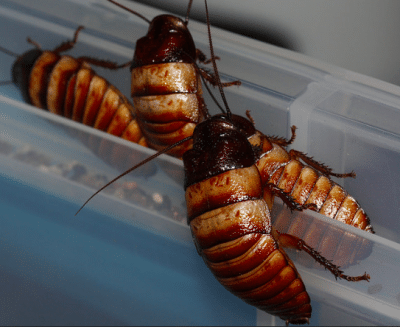
The dwarf hisser, as its name suggests, is simliar in many ways to the common hissers yet are about half the size. If kept warm, mostly dry, and fed a diet of fruits, veggies, and protein – this species will flourish and produce lots of very small nymphs. These little nymphs are particularly good at finding their way out of enclosures, so be sure to have a good, tight fitting lid. All hissers naturally come with hitchhiking beneficial mites that feed on the host roaches’ exoskeletal molds and excess food bits around the mouthparts. Adults reach ~1.4-1.6″.
CLIMBERS
Eurycotis decipiens
“Zebra Roach”
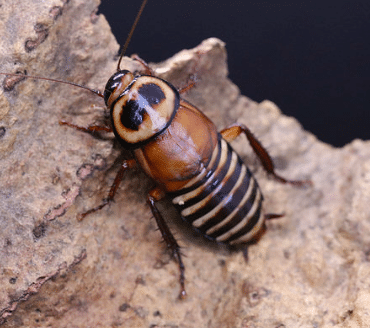
The zebra roach from Costa Rica is a beautiful and fun species. They are quite lively, often moving about in broad daylight. Nymphs start off black, then turn red, followed by the striping which they maintain into maturity. They are excellent climbers, and the small newly hatched nymphs are also good escape artists. This species is hardy if given moist conditions with good ventilation. For whatever reason, they don’t care for egg crate but do love to spend time in cork rounds. They go crazy over grain based dog foods and most fruits. Seeing a group of adults eating amongst eachother can be a very rewarding sight for the blatticulturist.
CLIMBERS
The Chinese medicinal roach, also known as the turtle roach, is an interesting, sexually dimorphic species. Males are fully winged while females lack wings entirely. They are a slow grower, and spend just about all of their time beneath substrate. They prefer a moist substrate though they can tolerate dry periods. These are a hardy roach that with some patience will grow and reproduce easily. They get their name because of specific compounds produced within their bodies that aid in certain disease treatments including cancer. Though only recent scientific evidence supports this, they have been involved in Chinese medicine many years prior.
Eurycotis improcera
(No common name)
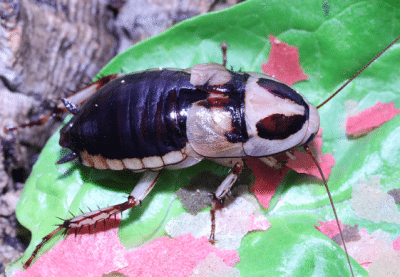
This is a beatiful species that is very new to the hobby. It is a smaller Eurycotis compared to the other US natives, and is about the size of E. decipiens and maybe a bit smaller. In fact their species name translates to “small”. They make up for their lack of size with their striking markings. Though smaller than other Eurycotis, it is still a larger species relative to other cockroach genera. This species likes more ventilation and dryness than the others, but is otherwise equivelent in care and temperament.
CLIMBERS
Eurycotis floridana
“Florida Skunk Roach”
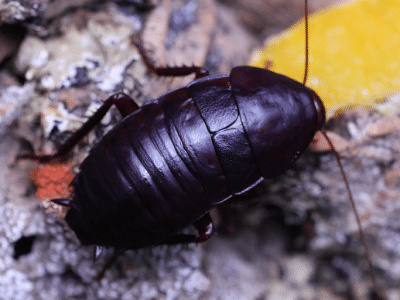
This Florida native species gets its name from the palmetto-like smell they produce when threatened that can be particularly potent. They are a very large Eurycotis species, and are actually good for handling since they are not exactly prone to releasing their defensive odor. Watch out, they do tend to nibble on hands though! These are excellent climbers like other Eurycotis. They lay huge oothecae that they tend to glue to various items in their enclosures, especially bark. Keep in a spacious container with good hides and plenty of moisture and these impressive roaches should thrive.
CLIMBERS
Gyna caffrorum
“Ghost Porcelain Roach”
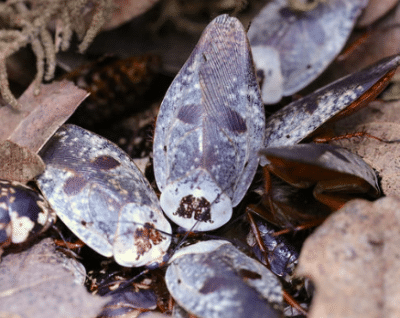
This beautiful species, also known as the chrome roach, is easy to care for and reproduces well in captivity. Like other Gyna, the females give live birth to a large number of tiny nymphs. Once your nymphs have hit adulthood and begin reproducing, you may be overrun with little nymphs quickly running about the substrate surface. These should be given a slightly moist substrate with a dry upper layer of leaf litter. They enjoy fruits and don’t eat a whole lot unless their numbers are high. Adults are great fliers, so be careful opening the lid of their containers when you see them active at various times of the day.
CLIMBERS, FLYERS
Gromphadorhina grandidieri
“Tiger Hisser”
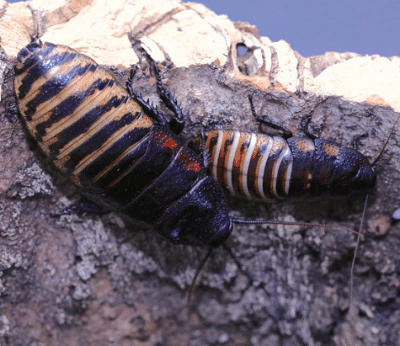
By far one of the most impressive roaches that deserves real estate in every collection display. The tiger hisser is very large, very colorful, great for handling, and easy to care for. They are a very popular pet roach species for the hobbyist or school classroom. Watch out, many places that offer hissing roaches nowadays are unknowingly selling hybrid specimens. These are pure tiger hissers that originally came from Orin McMonigle and have strong, clean coloration and striping. Despite this, their ID is uncertain and in Europe they are considered to be a tri-colored variant of P. vanwaerebecki. Give these a spacious enclosure with many hides and perches, and keep mostly dry.
CLIMBERS
Gromphadorhina oblongonota
“Wide Horn Hisser”

The largest Gromphadorhina, this tank of a roach gets its name from the male’s large pronotal horns that they use to quarrel with other adult males. We can’t emphasize the impressive size of this species enough – though the Macropanesthia are also a huge, bulky species, these are very comparable and are much more affordable and easier to care for. Like other hissers, they take a bit of patience to start a colony from a small group. However, under the right (warm, mostly dry) conditions you will have an impressive group of adults with little nymphs running around. Like the other hissers we offer, no hybrids here!
CLIMBERS
Gyna lurida (Yellow)
“Yellow Porcelain Roach”
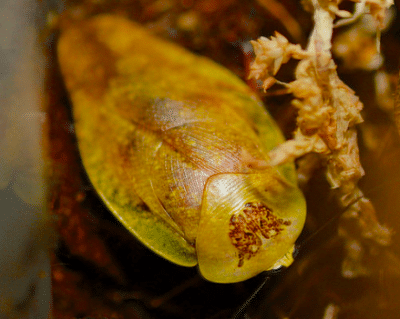
Long term hobbyist Orin McMonigle kept Gyna lurida for some time and noticed that within every large group there would pop up a few yellow individuals. He was able to isolate these individuals and breed them, which has over time produced a true breeding, beautiful yellow variety of G. lurida. Obviously, care is identical between the two morphs. Older individuals turn brown over time, but a freshly matured specimen is absolutely stunning with their canary yellow coloration.
CLIMBERS, FLYERS
Gyna lurida
“Porcelain Roach”
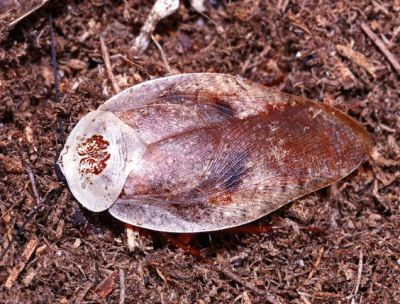
This is a classic Gyna species that is easy to rear. The porcelain roach is very similar in care and temperament to the ghost porcelain roach, enjoying a dry layer of mixed organic matter on top of their substrate in which the active nymphs will run around in. Be careful when digging around in the container as the adults are quick, strong flyers and you may be chasing one around the room for a while. This is the normal strain of G. lurida. There is also a yellow heirloom variety listed below.
CLIMBERS, FLYERS
Gyna centurio
“Centurion Roach”
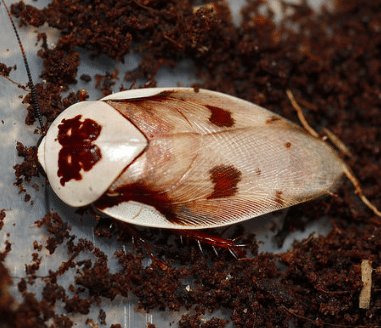
This is the prettiest Gyna species in our opinion. Though they look nice in photos, the real thing is most impressive. Like other Gyna the nymphs are relatively shy and spend most of their time beneath the substrate which should be fairly moist but never wet, and full of “stuff” (moss, leaf litter, bark pieces, etc). This is a pretty easy to keep Gyna species that reproduces well in captivity. Unfortunately, they need to be dug up to be shown off. Digging into the substrate to find your first adult can be a very exciting experience though!
CLIMBERS, FLYERS
Gyna capucina
“Pink Roach”
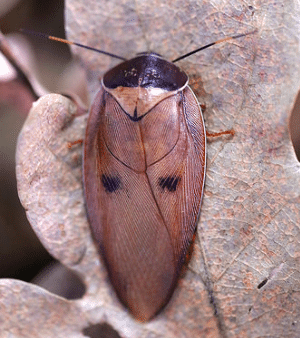
This beautiful and large Gyna species is on the brink of hobby extinction. They are kept by very few hobbyists and are particularly difficult to breed in captivity. Because of this, they remain rare and prices remain high. We are doing our best to establish a healthy colony! Part of their breeding success likely includes a deep, chunky but soft substrate with a moist layer at the bottom and drier toward the surface, and covered in leaf litter. They need room temp to warm conditions and should be fed a variety of fresh food items. Other than this, the rest is hoping and waiting. Fortunately, nymphs to adults are forgiving and seem to do well – it’s just getting them to reproduce is the issue few have had the honor to see.
CLIMBERS, FLYERS
Gromphadorhina portentosa
“Madagascar Hisser”
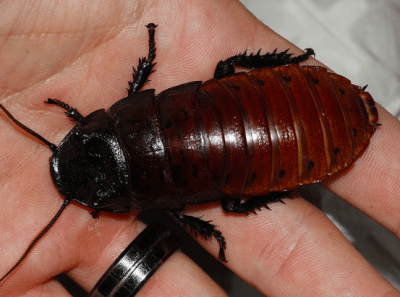
The hobby classic that started it all for many cockroach enthusiasts is the common or Madagascar hissing cockroach. These behemoths are a beautiful deep orange color with some black. They thrive under warm and dry conditions when given regular fresh produce and protein. These are a very popular classroom pet and can often be found in zoos, especially those with hands on displays for kids. These, like our other hissers come from pure lines and are not hybrids. These will readily hybridize with the other Gromphadorhina and must be kept separated.
CLIMBERS
Gyna bisannulata
“Patchwork Roach”
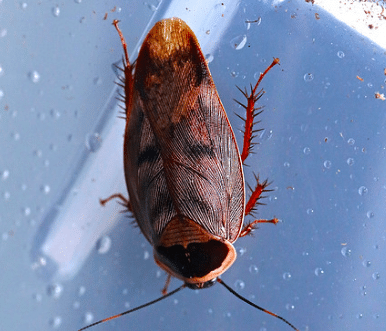
The genus Gyna is full of some spectacular, colorful species of cockroach – many of which are diurnal as adults. The patchwork roach, unforunately, has been extremely rare and fragile in culture. Though they appear easy to rear, getting females to reproduce has proven to be very tricky. The same is true of G. capucina below. Just about all Gyna prefer a slightly moist, soft, chunky substrate for nymphs to burrow into. This should be topped off with a drier layer of substrate and crushed, dried leaves. We are doing our best to get this species established here and hope to soon offer nymphs for sale to very serious breeders.
CLIMBERS, FLYERS
Hemiblabera tenebricosa
“Broad Keys Roach” or “Horseshoe Crab Roach”
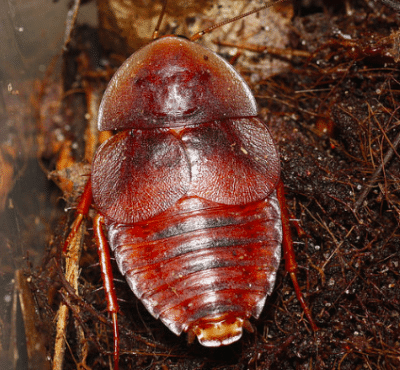
This very large US native, also known as the horseshoe crab roach, is an impressive and easy to rear species of roach. They enjoy a deep, moist substrate to burrow into. Interestingly, this is one of a few tropical roach species that will thrive and reproduce in room temperature and even a bit below, though they do best if given at least 70-80F temperatures. The adults are sexually dimorphic if paying close attention to the tegmina which are much more rounded in males. Males also tend to be a bit smaller than females.
Henschoutedenia flexivitta
“Giant Lobster Roach”
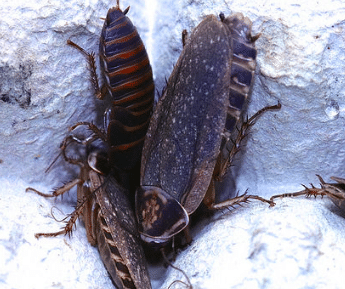
The giant lobster roach is essentially the larger version of Nauphoeta cinerea, as its name suggests. They are a good sized roach, are very fast, and are excellent climbers although smaller nymphs seem to be a bit clumsy at times. Many times have we chased nymphs around the rim of their container only to have them fall or jump off at some point. This species does well in drier conditions as long as they have regular access to moisture, as ours seem to reproduce more frequently when kept drier. These have a very good appetite and enjoy typical roach fare, especially fruits and veggies. One more fascinating thing about this roach is that adults literally squeak when scared!
CLIMBERS
Ischnoptera deropeltiformis
“Dark Woods Roach”
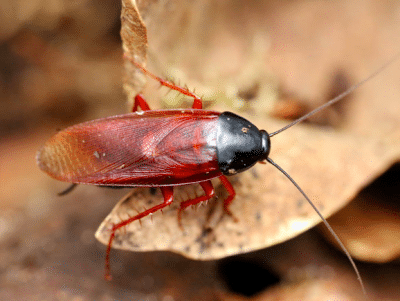
The dark woods roach is a very attractive, native American species that is very similar to some Parcoblatta in both care and temperament. Males are fully winged and capable of flight, while females have much shorter tegmina and are not capable of flying. There are at least two wing color forms, the “Ruby Red” variety (pictured) which were collected by Alan Jeon and the standard black variety much more commonly encountered. Both varieties have nice bright red legs though, which is why some call this the “sexy legs roach”. We currently have colonies of both varieties. This species is relatively easy to keep if given warm and moist conditions with plenty of bark, mosses, and leaf litter to hide in.
CLIMBERS, FLYERS
Lucihormetica verrucosa
“Warty Glowspot Roach”
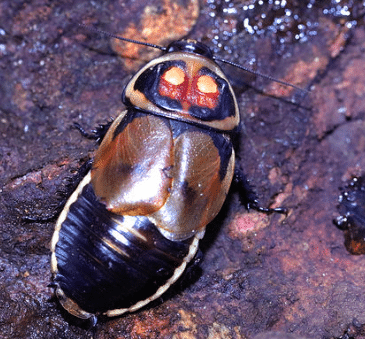
This species is almost identical to L. subcincta except that they have a bumpier pronotum and different wing pads. This species is also a bit hardier, and breeds much more easily. Otherwise, the duration from nymph to adulthood is quite long as usual, but is worth the wait. This is a great display species that is also great for handling. Keep moist in a deep substrate with some bark hides. Adult males especially will often perch on the top of their hides during the day.
CLIMBERS
Luridiblatta trivittata
“3-Lined Cockroach”
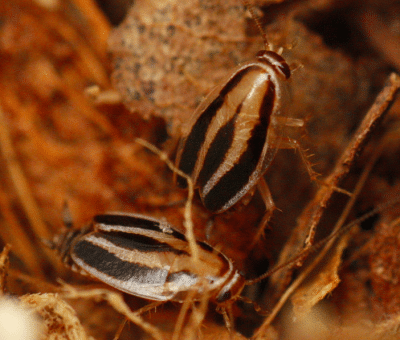
This fascinating, tiny, seasonal species somehow accidentally made its way to the bay area in California around 2009. Since then, it has spread throughout most of the area though it seems to be doing no harm. They are tricky to keep in captivity, requiring a very dry enclosure with regular water access. We keep ours in a large tub of leaf litter with high ventilation and there is a pile of water crystals in one corner. They can handle cooler temperatures but do best when kept warm, or even hot. The oothecae act like seeds, they need to be mostly dry for a long period of time, and then hatch when watered some months later. Read THIS post of ours for more information regarding the culturing of this species. Colony originally came from adults collected in Larkspur, CA.
CLIMBERS
Lucihormetica subcincta
“Glowspot Roach”
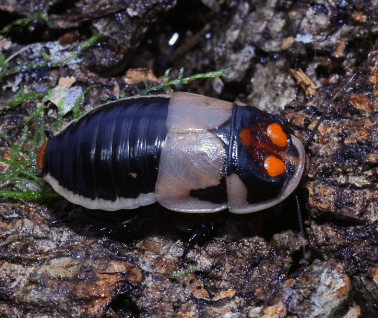
The genus Lucihormetica is a fantastic group of roaches that are quite large, great for handling, and often very colorful. The males in particular are fascinating with their glowing eye spots on the pronotum that range from yellow to orange. They are a very slow growing genus, with nymphs taking a year or two to mature and remaining beneath the substrate most of that time. Adults are worth the wait though, and are quite long lived themselves. Feed a diet of fruits and veggies with plenty of protien, and offer deep moist substrate with a couple bark hides and this species should bring you years of enjoyment!
CLIMBERS
Loboptera decipiens
“Lobe Winged Cockroach”
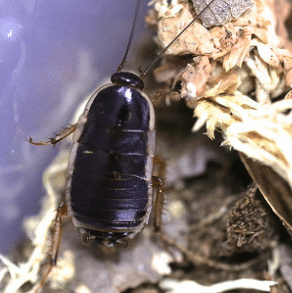
This recent addition to the hobby is a unique, lively little species from the middle east and some european countries. They are quick and good climbers, but tend to remain within leaf litter if provided. Adults of both sexes lack wings and thus cannot fly. These prefer dry conditions with regular small mistings or water crystals (or both). They enjoy fruits, veggies and leafy greens as well as dog food kibble/fish flakes for protein.
CLIMBERS
Latiblattella rehni
“Rehn’s Palm Cockroach”
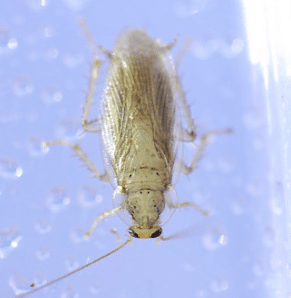
There seem to be many Florida-found Ectobiids that mostly go unnoticed and this species is one of them. Like many other Ectobiids, these require regular access to moisture yet will die in stuffy conditions. Humidity should be present but low, and ventilation should be high. We suggest leaf litter and mosses for this small species and their nymphs to hide in. These are very fast, good climbers, and good flyers.
CLIMBERS, FLYERS
Macropanesthia rhinoceros
“Rhino Roach”
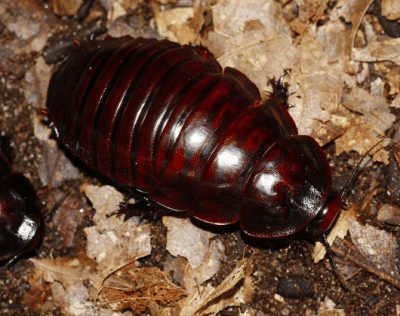
This is probably the most impressive and sought after cockroach species when it comes to size/girth. These enormous roaches come from Australia where they live underground in burrows and feed almost exclusively on decaying leaf litter. In captivity, they need to be kept in shallow, moist substrate and provided plenty of crispy, decaying oak leaves. Their high price is mostly due to their large size and how long it takes to reach it. Nymphs can take 3-5 years to mature! Because of this slow growth rate, the demand for big, impressive roaches, and that females only produce once a year – these will never be an abundant, cheap species in the hobby. We have several pairs of these that are ~2 years old now, we hope to have babies available within the next 2 years.
Neostylopyga rhombifolia
“Harlequin Roach”
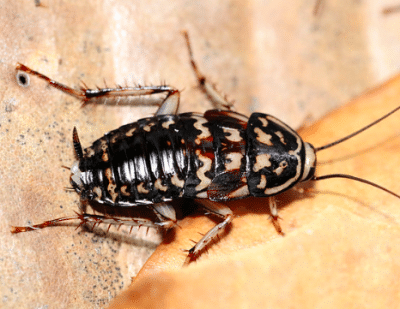
This beautiful and rare species is found in various circumtropical areas throughout the world. They range from having a yellow background with deep brown reticulated markings, to almost entirely black with hints of yellow. It is an extremely quick species that are particularly good climbers. They seem to be very sensitive to lack of ventilation with too much moisture. If you begin to notice many nymphs or adults with missing or partially missing limbs, increase the ventilation. Despite the good ventilation, they do prefer a moist environment with lots of hiding places.
CLIMBERS
Nauphoeta cinerea
“Lobster Roach”
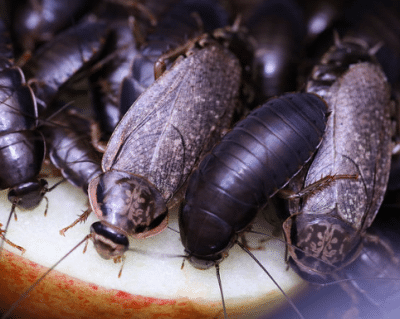
This is an extremely prolific, easy to keep roach species that is a fairly popular feeder. They are soft bodied, which makes them a great feeder for more fragile reptiles, smaller tarantulas, etc. However, they are excellent climbers of smooth surfaces. The lobster roach, which looks nothing like a lobster, has been around for quite some time and has introduced itself to many places including Florida and Hawaii. These do best with some substrate for the smaller nymphs to hide in, and larger nymphs and adults should be given several layers of egg crate especially as the colony increases in number. Though these are very hardy, they prefer some moisture and should be fed regularly as we have personally witnessed cannibalism of young nymphs and freshly molted individuals (though this may be a good thing to help control numbers). Despite this, colonies explode when given regular attention.
CLIMBERS
Neoblattella detersa
(No common name)
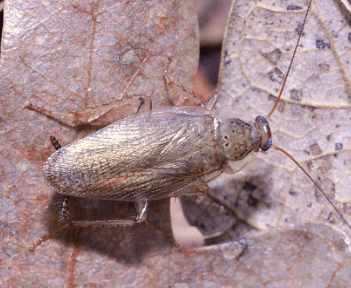
Yet another little Floridian Ectobiid! This species looks very similar to Latiblattella rehni but are a smaller. They are also similar to L. rehni in care, and watch out for ther quick speed too that is typical of many Ectobiids. We keep ours in a spacious container full of leaf litter and mosses, kept mostly dry with water crystals and frequent lite mistings. With the right angle and flash, these appear to have bright blue eyes in macro photography.
CLIMBERS, FLYERS
Opisthoplatia orientalis
“Red and Black Roach”
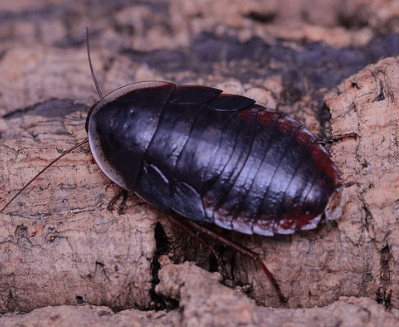
This great little underrated species is quite unique. Young nymphs are a rich brown and resemble little leaves. Once reaching adulthood, in a single molt they go from this brown coloration to a striking black to purple color with red and white margins. Though they come from a very moist/wet Malaysian environment, these don’t do well in soggy conditions in captivity and must be given moderately humid conditions with good ventilation. They are climbers but tend to remain hidden beneath bark on the substrate. Also worth noting, adult females are always about double the size of adult males. We wish more people kept these very pretty roaches!
CLIMBERS
Oxyhaloa deusta
“Redhead Roach”
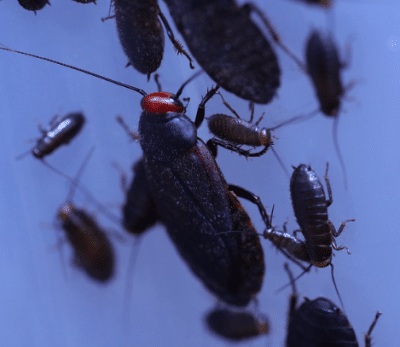
The red head roach is a very easy to culture and attractive little roach with their black body and bright red head. These are excellent climbers and so a tight fitting lid is a must to keep this species. They prefer things mostly dry and need hiding places, though some will wander around their enclosure throughout the day while others remain hidden. These will eat regular roach fare, however we have noticed that their absolute favorite food are dried oak leaves at the right stage of decay (the crispy, fragile kind). A decent sized colony can turn a handful of dried oak leaves into leaf skeletons overnight!
CLIMBERS
Panchlora nivea
“Green Banana Roach”
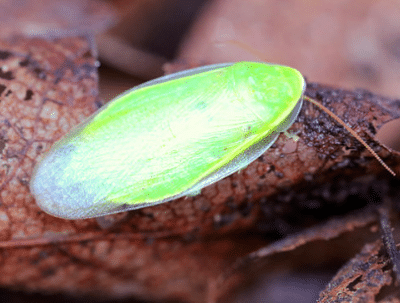
The green banana roach has found its way around the world with produce exports from its native countries. The adults are a beautiful, bright green coloration with yellow stripes down the sides of the pronotum. Nymphs resemble Pycnoscelus and similarily spend just about all of their time in the substrate. The adults are very strong flyers and are also very fast. These prefer a very moist, warm environment and do best with a rotten log mixed into the substrate for the nymphs to hide and feed on. Leaf litter is also highly recommended. This is the most hardy and fast breeding species of this relatively fragile genus. It is occasionally used as a feeder, especially for things like chameleons and geckos.
CLIMBERS, FLYERS
Paraplecta sp “Kenya”
“Little Kenyans“
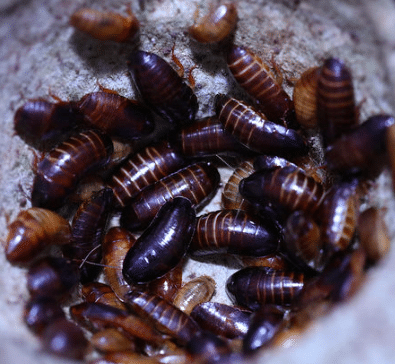
The little Kenyan roaches have bounced around with different names including Blaberidae sp “Kenya”, Paraplecta parva, and P. minutisima. Though they are likely P. parva, they have yet to be 100% identified. This is a very small roach species that spends most of its time hidden in substrate (which it basically requires to reproduce). Females give birth underground in chambers, so a chunky and moist substrate is highly recommended. These are often used in other roach bins with other species as a clean up crew since they’ll eat other roaches’ frass. It seems that most people can keep a colony of these going normally, while others have a group that breeds out of control. If the latter is true for you, keep in mind these do make a good feeder!
CLIMBERS
Parcoblatta americana
“American Wood Roach”
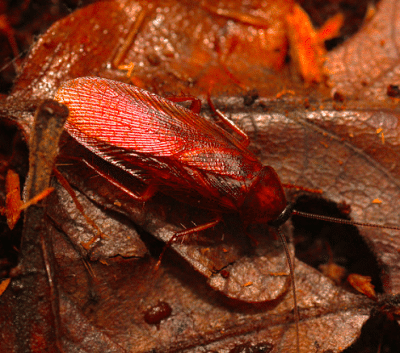
The north American genus Parcoblatta is full of a great variety of wood roaches. The American wood roach is a small to medium size (relative to others in the genus) mostly red to black roach that is one of the easier Parcoblatta to culture. These reproduce quite fast, and the nymphs seem to have a good success rate developing into adults. The males are fully winged, while the females’ tegmina have been reduced to almost nothing. They are good climbers but prefer to stay hidden beneath bark. This colony came from specimens we collected in Cottonwood, California.
CLIMBERS, FLYERS
Parcoblatta bolliana
“Boll’s Wood Roach”
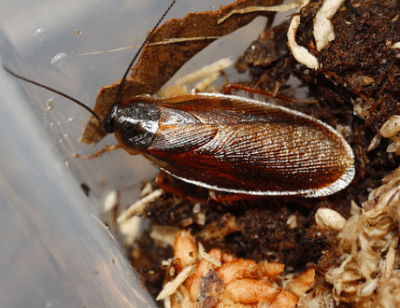
Boll’s wood roach is a very unique Parcoblatta that is difficult to culture in captivity. The fully winged males are usually a deep black coloration when freshly molted, often with a white border around the edge of the tegmina. As they age, they seem to turn a reddish color and look like other male Parcoblatta. Nobody has quite nailed down this species husbandry for a long period and we are working on this. Part of the problem with this species and many other Parcoblatta is that nymphs seem to mature in random waves, and these waves are usually either male or female. It’s not uncommon to have several adult males die off and then for several females to suddenly mature afterwards. It’s like a big missed high five!
CLIMBERS, FLYERS
Parcoblatta divisa
“Southern Wood Roach”

This species and P. zebra look quite similar. Males are fully winged and females also have wings, though they are noticeably shorter than the males. Nymphs of this species grow quickly and are quite hardy, but then seem to hit a dead end once reaching subadult size. In the wild this makes sense because many Parcoblatta overwinter as subadult nymphs to then mature in the spring. Unfortunately this means they may require a cool period or simply a length of time before adults mature. Typically, the males will mature more quickly than the females. Keep on leaf litter with bark for hides.
CLIMBERS, FLYERS
Parcoblatta fulvescens
“Fulvous Wood Roach”
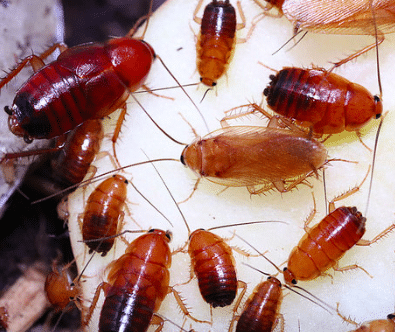
Finally, a super easy Parcoblatta! P. fulvescens can practically be used as a feeder. They grow fairly quickly, reproduce quickly, and there’s none of the ‘no males when there’s females and vice versa issues. They also keep on doing their thing as long as temperatures are stable. Males of this species are fully winged while females have nice little round tegmina. They prefer a moist environment, ideally full of leaf litter and bark hides though they will utilize egg crate too. If you want at least one Parcoblatta species, get these. They won’t disappoint!
CLIMBERS, FLYERS
Parcoblatta lata
“Broad Wood Roach”
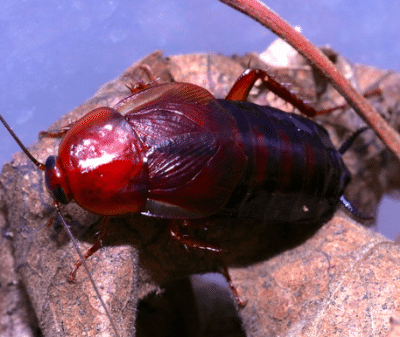
This is the largest Parcoblatta species. They are relatively easy to culture, the trick is getting a female to mature when a male is still around. This is why for all Parcoblatta we highly recommend starting with a good number of mixed individuals to ensure the likelihood of at least one pair maturing around the same time to keep the colony going. Keep these on a bed of leaf litter with moist substrate, and plenty of bark hides.
CLIMBERS, FLYERS
Parcoblatta pennsylvanica
“Pennsylvania Wood Roach”
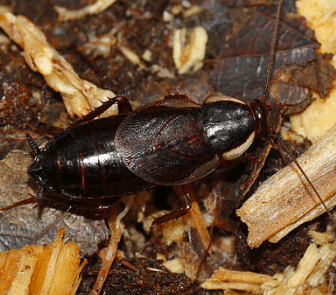
This is our favorite species of Parcoblatta. The adult females are large and dark in color, with some white bordering the edges of the body. The males are fully winged and also have the white edges, looking like large male P. bolliana. These are found in the north eastern USA, and seem to require an overwintering period each year in order to thrive. If you can provide this along with some moist substrate, leaf litter, moss, and bark pieces, they should do quite well. Our colony began from individuals collected by a friend in Grantsburg, Wisconsin.
CLIMBERS, FLYERS
Periplaneta americana
“American Roach”
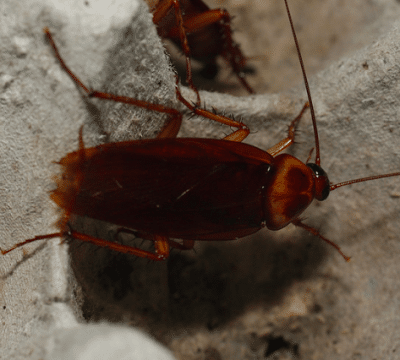
You know those huge, disgusting roaches that come out of the sewers and roam the streets of just about every city in the world? This is them! Though we hardly think they’re disgusting. It is worth noting though that these are technically a pest species, but they need regular access to moisture to thrive. These are lightning fast and fly very well. It is crucial to keep them in a large, escape proof container. They have a big appetite, reproduce fast, and in our opinion are quite fun to watch. These do have a “roachy” smell though, and if their numbers get too high you’ll need to figure out a way to change out their substrates and egg crate.
CLIMBERS, FLYERS
Periplaneta americana (White Eye)
“American Roach”
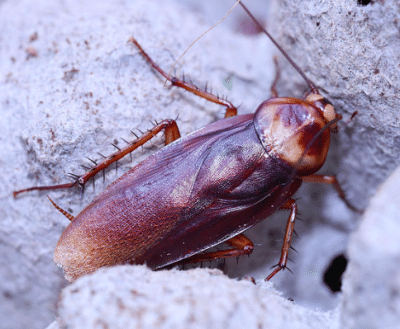
Everything you love about the nasty American roaches, but with super creepy white eyes! This is the oldest known cockroach mutation that has been cultivated for years. They are rumored to have first been found in an old, deep mine in Germany. Their care is the same as other Periplaneta. Keep moist and warm in a spacious container, and with a little food these will grow very fast and reproduce quickly. Keep in mind that all Periplaneta are ootheca cannibals. You may need to remove and incubate a few oothecae separate from the parent colony to keep them going. A way around this is to provide plenty of hides in the container and crevice-like places for the females to hide the oothecae in.
CLIMBERS, FLYERS
Periplaneta fuliginosa
“Smoky Brown Roach”
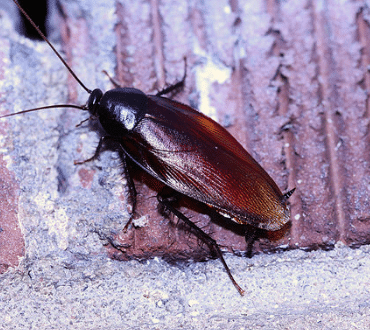
Another of the pest Periplaneta, the smoky brown roaches are one of our favorites. Newborn nymphs are “cute” with their long waving antennae and white stripes and spots. As they age they turn reddish and eventually end up being the darker colored adults. These are common in the American southeast where they are not exactly loved by the locals. Keep very moist and warm and these will thrive. Don’t forget about their oothecae-cannibalistic tendencies too.
CLIMBERS, FLYERS
Princisia vanwaerebecki
“Vibrant Hisser”
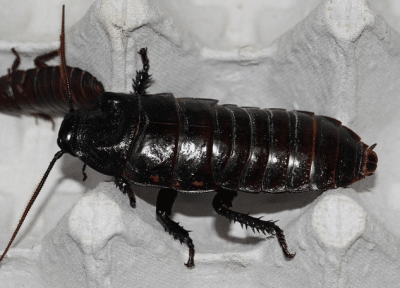
The validity of this large and impressive hisser species is uncertain. Some think it is completely invalid, and is just another hybrid Gromphadorhina species. It has been consistently shared around the trade with this label though and is a unique roach with its large size and mostly black exterior. Like other hissers, these should be kept dry and with hides large enough to accomodate their size. The males of this type seem to be mostly black while females have some orange, looking similar to E. laevigata females. Our colony comes from individuals purchased from Orin McMonigle.
CLIMBERS
Pycnoscelus femapterus
“Wingless Female Roach”
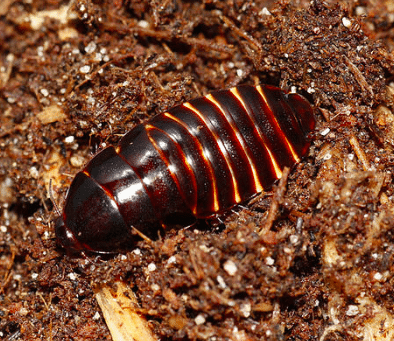
The genus Pycnoscelus is a very fun, easy to care for, and variable genus of roaches. The wingless female roach, as its ever so descriptive name suggests, is a unique species of roach where the adult females look like large nymphs lacking wings. Males are considerably smaller and are fully winged. These reproduce quickly in a deep, moist subsrate of just about anything.
CLIMBERS, FLYERS
Pycnoscelus surinamensis
“Surinam Roach”
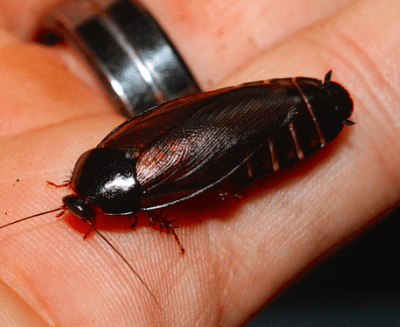
With enough females under the right conditions, the Surinam roach will breed absolutely out of control. Like P. nigra, it is parthenogenic. There are no males, and all females that reach adulthood will be pumping out nymphs left and right. It’s not uncommon to have a colony so thick that there’s more roaches than substrate. These have a ferocious appetite. They will swarm apple slices, dog food, and just about anything and before you know it it will be gone. If it wasn’t for their tendency to shoot into the substrate so quickly and if they couldn’t climb, they would make an awesome feeder roach. Keep moist in a deep subsrate.
CLIMBERS, FLYERS
Pycnoscelus sp. “Thailand”
(No common name)
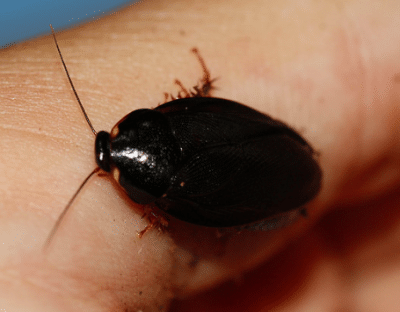
This is a relatively new and prolific Pycnoscelus species from Thailand that is somewhere between P. nigra and P. surinamensis. Most of the adults have the black wings like P. nigra but not quite as long, and they also have a yellow spot on each side of the pronotum nearest to the head, whereas P. nigra are entirely black. The rest of the adults pop out very similar looking to P. surinamensis. These do well kept like the other species in a moist, deep substrate.
CLIMBERS, FLYERS
Panchlora sp. “Speckled”
“Speckled Banana Roach”
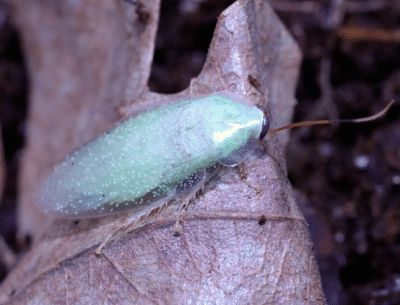
A unique and beautiful blue-green Panchlora with a light background and small speckles. These were made available by Gil Wizen and originated from Ecuador. These are quite rare and new to the hobby, but have been shown to be a hardy and prolific species of Panchlora. As per norm for the genus, nymphs remain in the moist substrate most of the time while adults perch on various decor within their enclosure. They are strong, quick flyers so be careful as you root around in their container!
CLIMBERS, FLYERS
Panchlora sp. “Giant”
“Giant Banana Roach”
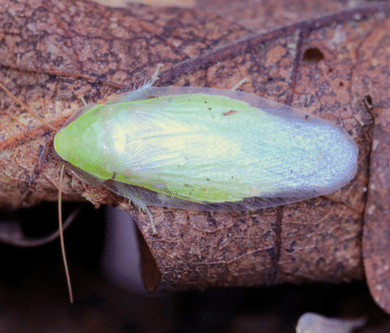
The giant green banana roach, as its name suggests, is the giant version of Panchlora nivea being almost double the size. It is clearly a different species considering the larger size and different genitalia. Despite being around for quite some time, it has yet to be identified and a lot of this has to do with an unknown origin. Like the green banana roach, this larger species is also green though is significantly lighter. These also don’t seem to reproduce as fast, but are just about as hardy as P. nivea. Like the other Panchlora, these move quickly and fly very well as adults.
CLIMBERS, FLYERS
Panchlora sp. “Costa Rica”
“Yellow Banana Roach”
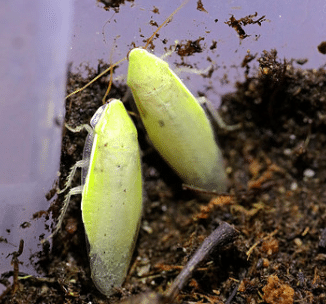
A beautiful banana-yellow banana roach! These come from northern Costa Rica. The original group produced both green (just like P. nivea) as well as bright yellow individuals. The yellow individuals were then isolated by Kyle Kandilian, who was then able to produce a true breeding yellow line of this beautiful roach. This all said, they are quite new to the hobby. Fortunately, they seem to do quite well in captivity and both grow and breed easily if given a moist substrate, leaf litter, and ideally a rotting log.
CLIMBERS, FLYERS
Panchlora sp. “White”
“White Banana Roach”
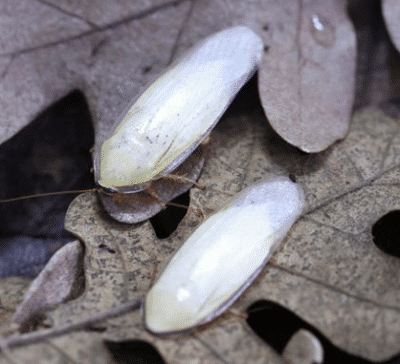
Another outstanding Panchlora species made available by Canadian entomologist Gil Wizen! These are a beatiful ivory white color as adults and are comparable in size to the giant Panchlora. These come from Belize, and are extremely rare. They have also proven to be difficult to culture, with females taking their time to give birth to only a handful of babies (or, sometimes never). Add this to the fragility of the adults and you’ve got a tricky species to deal with. We are doing our best to get a healthy colony of these before offering any for sale.
CLIMBERS, FLYERS
Paratemnopteryx couloniana
“Goblin Roaches”
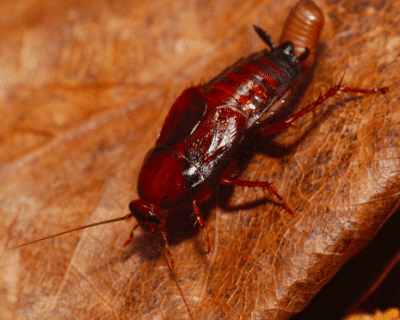
The Goblin roaches are a neat little species that are visually similar to Blatta lateralis yet are not very closely related. Adults have short tegmina and cannot fly, though adult males seem to climb well when disturbed. These prefer a moist environment with plenty of hiding places, such as bark or egg crate. Though they don’t reproduce as fast as B. lateralis, they are often used as feeders since they are easy to cultivate in medium numbers. This is a fun and easy species that should be a part of any roach collection.
CLIMBERS
Pseudomops septentrionalis
“Pale-Bordered Field Roach”
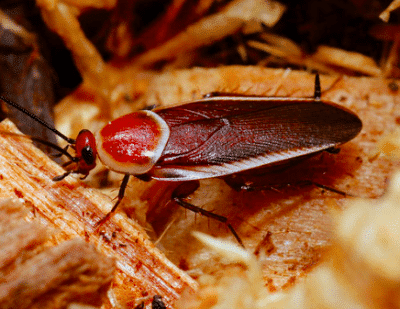
This beautiful little north American species can be a bit tricky to culture. The nymphs seem to take a very long time to mature, and tend to mature randomly when they do. If a colony is started with small numbers, it is more than likely to die out. Similar to some Parcoblatta in this respect, we try to combat this by offering a larger starter colony size of 20. Keep these moist at all times. We recommend a bark slab on top of leaf litter, and also recommend using New Zealand sphagnum moss as a good water-retention source built into their habitat.
CLIMBERS, FLYERS
This HUGE sand roach species requires significant patience on the hobbyist’s part. They take quite a while to mature, and oothecae take quite some time to hatch. The wait is worth it though! Interestingly, this species is parthenogenic. This means that no males are present – females lay viable oothecae that hatch out as little clones of mom. That said, if you can raise a single specimen to adulthood successfully – you can start a colony from a single specimen. Keep these in a chunky, bone dry substrate of mixed organic matter (but avoid wood/bark chips). Occasionally mist one corner of the enclosure and feed dog food kibble for protein.
Parcoblatta virginica
“Virginia Wood Roach”
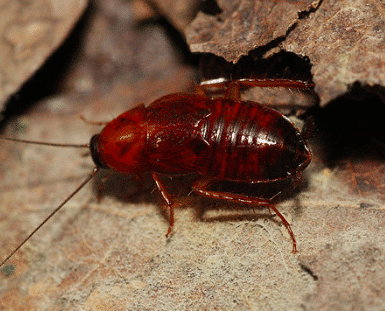
The Virginia wood roach is the smallest Parcoblatta species, being about half the size of the rest as adults. They are a mostly red coloration. Females have small tegmina and males are fully winged. This is a fairly easy to keep, common species though less and less people seem to be showing interest in it despite their ease of care. These are common around the eastern and northeastern USA.
CLIMBERS, FLYERS
Parcoblatta uhleriana
“Uhler’s Wood Roach”

This interesting little Parcoblatta has dark females with unique, small tegmina. Males are fully winged and are an overall orange coloration. Keep this species like other Parcoblatta in a container with good ventilation, moist substrate, leaf litter and bark. These and other Parcoblatta will eat a variety of fruits and veggies, and seem to be especially fond of cucumber.
CLIMBERS, FLYERS
Parcoblatta zebra
“Banded Wood Roach”
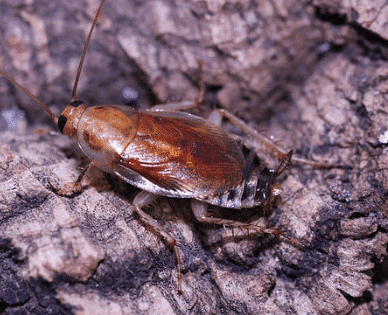
The banded or zebra wood roach is a very nice little Parcoblatta species that comes from swampy conditions where it is typically found beneath bark. In captivity, they enjoy plenty of moisture and good cavernous pieces of bark or wood. As usual, we suggest leaf litter, rotting wood and mosses mixed in their container as well. Males of this species are fully winged, females wings are a bit shorter. This species is relatively easy to culture however the oothecae in our experience have shown to be picky about when they’d like to hatch.
CLIMBERS, FLYERS
Periplaneta australasiae
“Australian Roach”
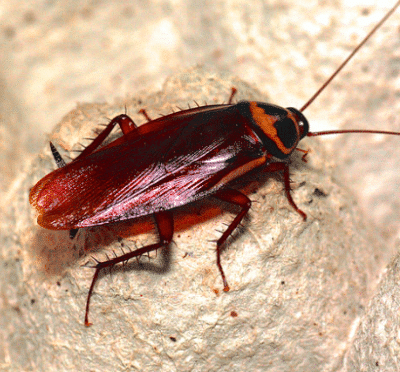
These are the most attractive Periplaneta. The nymphs are especially colorful with their yellowish spots and striping on a maroon background. Adults also have crisp, contrasted patterns. These are a circumtropical pest that have taken advantage of green houses. They do well in captivity under warm, moist conditions. Like many other Periplaneta, these are lightning quick, are strong flyers, and happily eat their own oothecae – all of which should be taken into account when keeping this species.
CLIMBERS, FLYERS
Periplaneta brunnea
“Brown Roach”
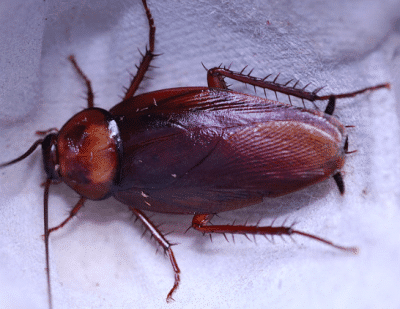
At a quick glance, these look identical to Periplaneta americana. With a closer look though, you’ll find that there’s something different about their pronotum coloration, and their cerci are also different. This is also a circumtropical pest, though seems to be overwhelmed by P. americana. Their care is similar to other Periplaneta, needing a warm, moist, dark environment and fed a diet high in protein with lots of fruits and veggies too.
CLIMBERS, FLYERS
Pycnoscelus striatus
“Ember Roach”
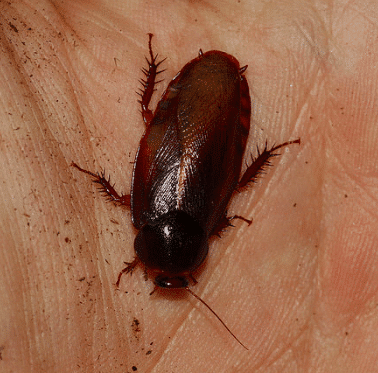
The is a very pretty species that is very shy like most other Pycnoscelus, spending almost all of their time hidden beneath substrate. These get their common name from their nice rusty orange coloration that makes them look like little sparks darting into the substrate. These are another easy species but seem to be the slowest to breed of the hobby Pycnoscelus. Keep in a deep, moist substrate.
CLIMBERS, FLYERS
Pycnoscelus nigra
“Shadow Roach”
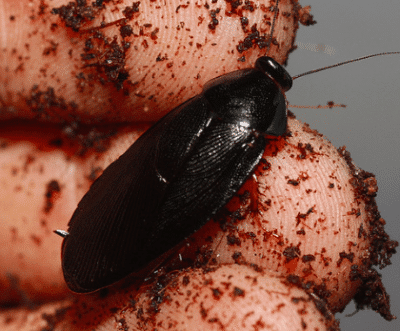
The is by far our favorite Pycnoscelus species that should be a part of every roach collection. These are a deep jet black color, and are super easy to keep. They are parthenogenic, and so colonies can explode fairly quickly though this species does not seem to reproduce quite as fast as P. surinamensis. Keep these in a deep, moist substrate and offer lots of fruits, veggies, and some protein. The colony may look like a tub of dirt most of the time, but they will swarm food when it is presented!
CLIMBERS, FLYERS
Phoetalia pallida
“Pallid Roach”
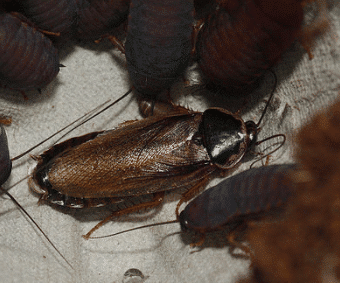
The pallid roach is a small, fast breeding roach species that is both commonly kept and commonly used as a feeder. They breed very quickly, and are similar to N. cinerea in some respects including their great ability to climb. Watch out, I’ve noticed that these will nibble on just about anything including the seals of some gasket containers. Keep these warm and mostly dry with occasional mistings. They enjoy most roach fare and seem to breed at a surprising rate despite their smaller appetites.
CLIMBERS, FLYERS
Polyphaga aegyptiaca
“Egyptian Sand Roach”
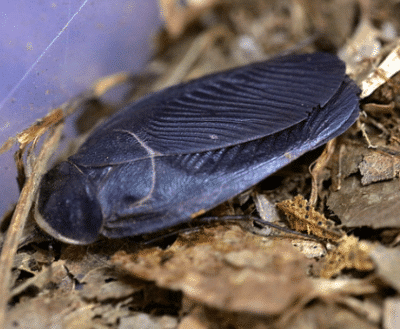
The Polyphaga are a fascinating group of desert adapted roaches. This particular species comes from the Sinai region of Egypt. They are large, way bigger than Arenivaga species. Males are mostly black and are fully winged, while females are completely without wings. These need a bone dry substrate that is at least a few inches deep. It should be soft and full of organic matter. We use a mixture of dry peat, coco, soft sand, crushed oak and mesquite leaves. These will eat the dried leaves but also enjoy dog food kibble. Only mist one corner of their enclosure and otherwise keep dry.
FLYERS
Rhabdoblatta formosana
“Taiwanese Leaf Roach”
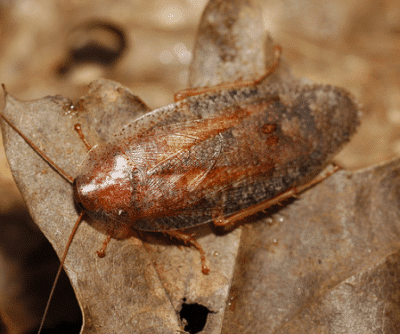
This uncommonly kept roach is almost impossible to see in plain sight when perched on a bed of leaf litter. They are a decent size, reaching about 1.5″ as adults. This species has an extremely fast metabolism. They readily consume most food items including some dried leaves, and produce massive amounts of frass. Because of this, they do not tolerate neglect as the frass builds up and creates a very poor environment for the roaches. If substrate is changed occasionally and plenty of moisture and leaf litter is provided, this species should do quite well otherwise. These are very similar to E. maya.
CLIMBERS, FLYERS
Simandoa conserfariam
“Simandoa Cave Roach” and “Extinct in the Wild Roach”
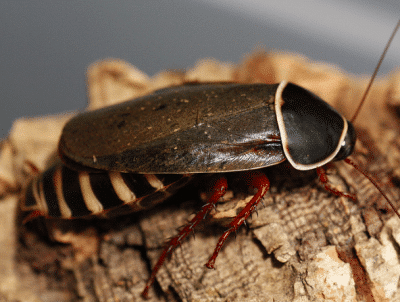
This amazing roach has a very significant story. Their other common name is “extinct roach” and this is because they were only ever found in a single cave system in west Africa which has since been destroyed for mining. Fortunately, before the destruction of the cave a group of scientists were able to not only collect and describe this species, but also were able to cultivate it in captivity. Now, roach hobbyists are the sole reason this species continues to exist! They are a magnificent roach with very colorful nymphs and very impressive adults. Feed fruits and veggies with protein, and keep moist with good ventilation. This species makes a great display not only due to their story, but also because the adults often prefer to perch right in the open!
CLIMBERS
Supella longipalpa
“Brown Banded Cockroach”
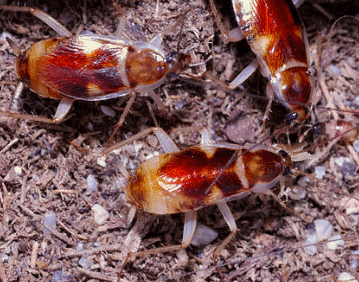
This is a widespread pest among humans, especially in messy dorms and old libraries. They are very tolerant to dry conditions having originated from an arid region of Africa. In captivity, they can be kept in an escape-free container with only water crystals or the occasional misting as a water source. They will eat just about anything and are especially fond of fish flakes. Though these are arguably a worse pest than B. germanica, these seem to be much more manageable due to their relatively slower, relaxed movements and are therefore less likely to escape. Nymphs are tiny and easy to miss though, always check lids carefully! Though we thoroughly enjoy rearing these and offer them here, don’t forget these will happily live and reproduce in your home.
CLIMBERS, FLYERS *PEST
Schultesia lampyridiformis
“Firefly Mimic”
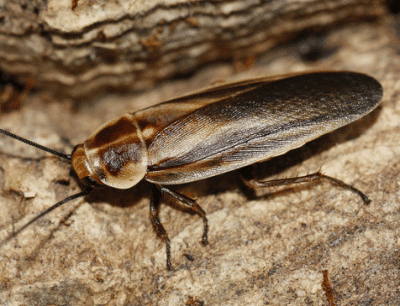
This fascinating little roach looks like a firefly as an adult, but without the glowing abdomen unfortunately. They are easy to culture having a fairly quick life cycle and breeding easily. They prefer a warm, moist environment with plenty of hiding places. If this is provided, you should in time have lots of them running around. For whatever reason, these have remained somewhat rare in the hobby despite their ease of care. Watch out, these are very good climbers though most remain around the bottom levels of their enclosures.
CLIMBERS
Therea olegrandjeani
“Question Mark Roach”
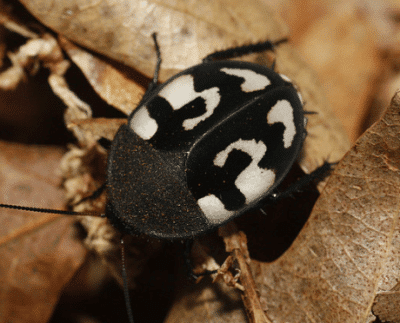
One of the most popular and well-loved cockroach genera. The Therea are a dazzling, easy to care for group of roaches from India. The question mark roach is no exception to this with their black background and white markings that resemble a question mark when viewed from the side. Nymphs spend their time in the substrate and take about a year to mature into the beautiful, short lived adults. Adults lay lots of oothecae and then die off shortly after, beginning the cycle over again. Keep dry leaf litter on top of a slightly moist, chunky substrate and these will be very happy. Therea tend to mature male-heavy and so larger starter colonies are recommended unless there is no intention of breeding.
CLIMBERS
Therea regularis
“Orange Domino Roach”
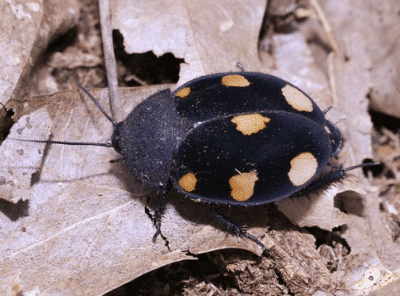
This is the look alike species to T. petiveriana – only with great pumpkin orange spots in place of the white. Like the other two species, you must have great patience when beginning a colony of nymphs. Once they reach adulthood though, they do not dissappoint. The females lay quite a few oothecae which hopefully hatch an abundance of little nymphs at different times. Ideally, the hobbyist ought to hold back many mixed sizes so that most of the time in the near future there will always be a few adults. Like the others, keep in a deep, soft, moist and chunky substrate with a dry layer of leaves on top. These eat standard roach fare, especially apple and fish flakes.
CLIMBERS
Therea petiveriana
“Domino Roach”
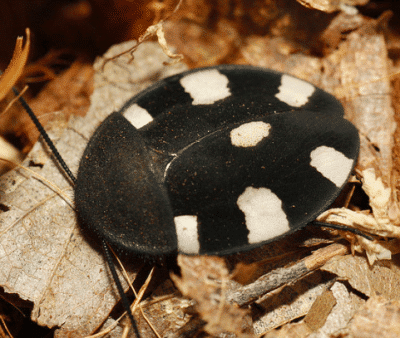
The most common response we get when showing off a colony of Therea is “huh, that doesn’t look like a roach”, often shortly followed by a “they’re cute!” The domino roach is a magnificent roach with their black body and white spots, very much like a reversed domino. Though they take a long time to reach adulthood and are short lived, the wait is worth it and so is the couple months of watching the adults comically run around the leaf litter chasing one another. Keep these in a deep, lightly moist substrate with a dry leaf litter layer on top. Many people keep the nymphs and quickly lose interest, often neglecting or completely forgetting about them. The interest is completely resparked when the container of dirt and leaf litter comes to life with these little gems running around.
CLIMBERS
Blattidae sp. “African Bullet”
“African Bullet Roach”
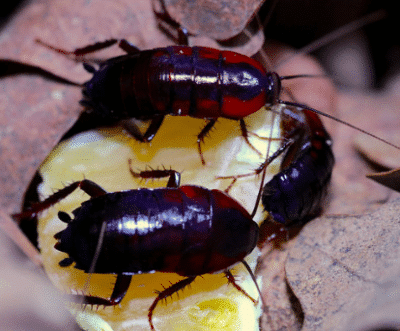
This great little roach species has yet to be identified though is thought to at least be a member of the genus Neostylopaga. They are a colorful little roach with an overall dark black body with red racing stripes on the edges of the pronotum that continue through the thorax. The flash of a camera especially brings out the red coloration. These prefer a spacious enclosure since they can be antennae nippers in crowded conditions. They also require decent humidity and good ventilation. If you can accomodate this, they will thrive and reproduce easily.
CLIMBERS
Ectobiidae sp. “Malaysia”
“Little Penguins”
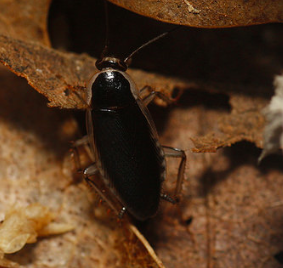
This little roach should have been given the name “little pain-in-the-butts”. They are very quick, and if their container is disturbed in the slightest way they will all run upwards immediately. If the lid is off, they will then catapult themselves over the edge and make a run for it in all directions. So, if you want to take a few years off of the packer’s life, order some of these to include in your box. Other than this, they are a relatively easy species to cultivate if given adequate moisture and good ventilation. Use a tight caging system to contain them and only open the lid very carefully when necessary!
CLIMBERS

